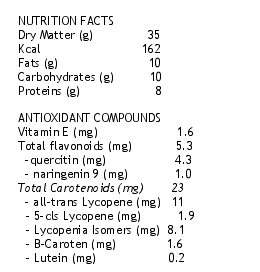 |
 |
 |
| |
Antioxidant-Enhanced Food Found To Reduce Ribavirin-Induced Anemia
Reported by Jules Levin
|
| |
| |
Vincenzo Fogliano from the Dept of Food Sciences at the University of Neoples reported results from "Use of carotenoid-based functional food minimizes the severity of Ribavirin-induced anemia in patients with chronic hepatitis C: a randomized study". There have been studies previously which examined the use of vitamin supplements in an attempt to reduce the Ribavirin-induced anemia but these studies have shown mixed results, without clear evidence of effectiveness.
Fogliano reported that oxidative stress plays a major role in the physiopathology of hemolytic anemia during ribavirin therapy. The efficacy of antioxidant supplementation (vitamin C and E as pure compounds) is still controversial. The Italian researchers conducted a study to verify if the supplementation with an antioxidant-rich tomato-based functional food reduces the anemia during peginterferon and ribavirin therapy for chronic hepatitis C (CHC). The presentation by Fogliano and the discussion from the audience was humorous as they joked how to Italians tomato sauce is a stable, so how could the control group in this study accept being randomized to not receiving the tomato sauce.
The use of ribavirin combined with interferon, for the therapy of HCV can result in a severe anemia. This side effect usually reverts when ribavirin is discontinued. One way in which to deal with reduced hemoglobin count resulting in anemia is to use Procrit. In study, the final results of which were presented at this DDW, Procrit has been shown to increase hemoglobin, relieve fatigue associated with anemia, and improve quality of life & capacity to take full dose of ribavirin.
A functional food with high content of natural antioxidants and demonstrated high carotenoid bioavailability was developed. The study researchers described the functional food composition (values per 100 grams of product):
|
|
 |
| |
I have no idea what some of these antioxidant compounds are so if you are interested you'll have to consult with a knowledgeable person such as a dietician.
92 patients with chronic hepatitis C infection (70 men, 22 females) were randomized equally to receive Peg-IFN 1.5 ug/kg/week plus ribavirin 1000-1200 mg/day plus the food (100 grams/day for 6 months) or Peg-IFN 1.5 ug/kg/week plus ribavirin 1000-1200 mg/day.
The authors maintain that antioxidants from food are more effective than from vitamin supplements. The authors also presented a slide showing bioavailability of carotenoids (Lycopene all-trans, Lycopene 5-cls, B-carotene, and Lutein) for the patientes in the study who received the food plus interferon/ribavirin compared to the bioavailablity for patients who received interferon/ribavirin without the food. The graph showed levels of these carotenoids from baseline to 1 month, and the levels of the 4 carotenoids in patients receiving interferon/ribavirin plus food increased; but in the study patients who did not receive the food, but only received the IFN/RBV, the levels of 3 of the 4 carotenoids decreased while levels remained the same for I carotenoid.
Both groups received similar mean ribavirin doses (13.51 mg/kg/day for treated patients vs 13.4 mg/kg/day for patients who did not receive food). The mean baseline hemoglobin levels were the same in both study patient groups (15.1 vs 15.0 g/dl). Average body weight was 76.3 kg for patients not receiving food and 72.6 kg for patients receiving food (2.2 kg=1 lb). Other demographics reported were the same between the two patient groups (age, male/female).
RESULTS
The outcome was evaluated after 12 weeks.
--0/46 and 0/46 patients in both groups withdrew from ribavirin
--4/46 (8.7%) of patients receiving food reduced ribavirin dose vs 14/46 (30.4%) who reduced ribavirin dose in the patient group not receiving the food supplement (p=0.009).
Mean Hemoglobin Levels During First 3 Months of Therapy
|
|
 |
| |
At each time point except at Day 60 and at baseline the difference in hemoglobin between the 2 patient groups was significant (p=0.05).
The authors concluded that the regular intake of carotenoid-rich tomato-based functional food reduce the severity of ribavirin-induced anemia in patients with chronic hepatitis C infection. The use of this functional food as adjuvant of pharmacologic (HCV) therapy improve drugs tolerance and the adherence to the therapeutic schedule.
|
|
|
 |
 |
|
|